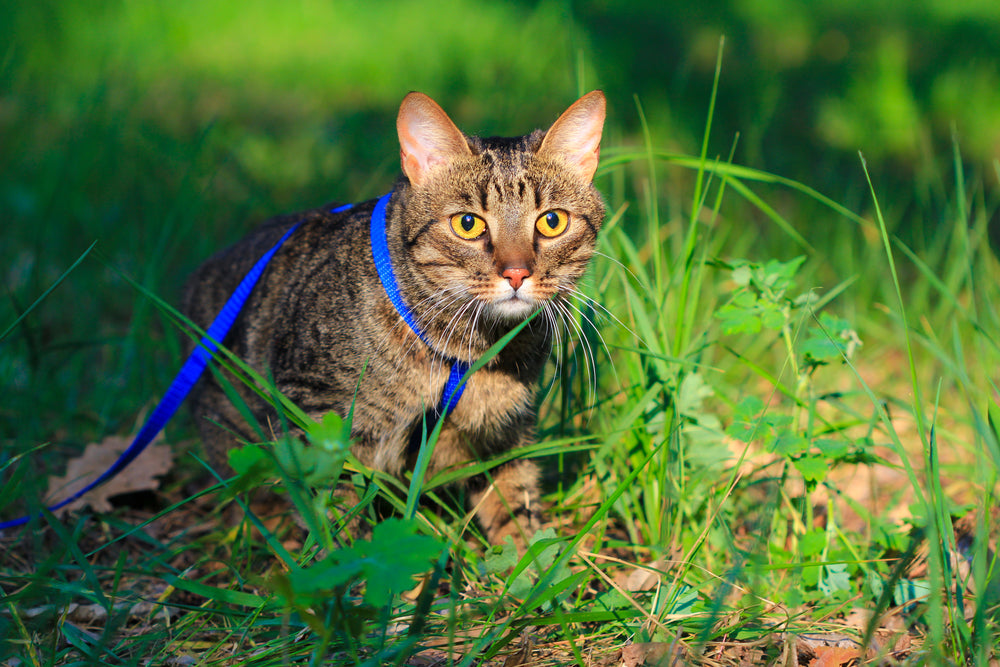This may seem like an odd blog post, but because we sell protective tape products to shield window sills and furniture from cat claw damage, and because we saw a cat walking on a leash, we wondered what are the best ways to walk your cat on a leash.
We talked with someone who walks her cat on leashes to find out why and how she made it happen.
First The Why You’d Walk Your Cat On A Leash
We found out some cats, definitely not all, are curious about the outdoors and may eventually take to a leash. Their curiosity may win out and they will allow you to put them in a harness and on a leash.
Spending time out of doors, in the grass and chasing bugs and simply being a cat is beneficial (again, for the cat who enjoys it) If your cat is scared of the out-of-doors, don’t force it.
You don’t need to actually “walk” the cat on the leash the same way you’d walk a dog. Fido enjoys long walks through the neighborhood, Fluffy probably won’t be interested. The “walking” is optional, it’s more about allowing the cat to safely explore.
5 Tips When Walking Your Cat On A Leash
- Get them accustomed to a harness by letting them see it, play with it, kick it around. Don’t bring a harness home and try to put your cat in it -- he will get stressed and you will probably get scratched. Slow and steady wins the race as cats aren’t typically known for being fond of clothing.
- Gently put your cat into the harness while you’re indoors and relaxed. If she’s sleeping on your lap, slowly put the harness on. She will wake up and she just might not be too happy, so plan on taking your time and easing her into it. Be advised it could take days or weeks OR you might have a cat who will never want to wear a harness. Cats are finicky like that!
- Once the harness is on, let your cat walk around the house and get accustomed to it. Be prepared for your cat to walk oddly -- all hunched up, for example. Your cat might even take a couple of steps then fall over. He may crouch to the ground and act as if the harness is weighing him down. Again, be patient and give him time to get accustomed to it.
- After your cat has worn the harness and is walking around with it and seems comfortable you can, try to snap on a leash and walk him. Chances are your cat will not “heel.” Some cats will, most can’t won’t. Don’t drag your cat or force her to walk. Let her drag the leash around inside the house, attached to the harness, and get accustomed to its weight. The leash is a safety measure for when your cat makes his way outdoors.
- Carry your cat outdoors or allow he or she to walk with you holding onto the leash. Let her explore. Don’t leave her outside alone. Always make certain she is firmly and safely inside the harness. Be aware that street noises, a car driving past, people shouting, a lawn mower, etc. could scare your cat and make her bolt. Never let go of the leash and stay in close proximity.
If your cats want to go outdoors, but won’t tolerate a harness or leash, consider setting up a large dog carrier that is fully enclosed. Remove the bottom tray and let your cats feel the grass and earth beneath their feet and the sun on their bodies. Please note that if your cats get a taste for the outside, they may be more prone to bolting toward the door when you open it, so be careful and ever vigilant.
Cats who are allowed out of doors should be microchipped or wear safety collars with your name and phone number on it. Cats who never experience the outside can be given a taste of it by providing them with a patch of “cat grass” indoors, giving them a sunny place upon which to sleep and opening the windows to give them a chance to breath in fresh air.
Just as dogs develop destructive behaviors when not given enough exercise or attention, so too can cats. Make certain your cats have mental stimulation and exercise. Give them a toy to chase, a puzzle game to dispense their food and let them be house cats if that is what makes them most comfortable and happy.
Clawguard builds shields that help protect homes from damage caused by dogs and cats. Products include door shields, furniture protectors, and universal protective tape that protects commonly scratched areas like window sills, furniture, banisters, weatherstripping and more.
